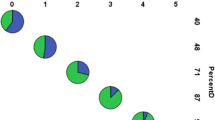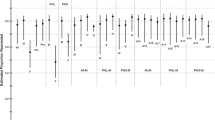Abstract
Using large sample archival data from the state of South Carolina’s juvenile justice agency and other state agencies, we examined the background, early experiential and delinquency-related variables predicting young adult (ages 17–30 years) offending among juvenile offenders. We also examined characteristics of juvenile offenders who committed only a single misdemeanor offense, compared to non-juvenile offenders. Finally, we examined the variables that accounted for group differences in persistence of juvenile offending. Early adverse experiences including family-related adversities, mental health problems, identification as having school-related disabilities and juvenile recidivism accounted for more than 20 % of the variance in adult offending. Cox proportional hazards analysis revealed several time-dependent covariates including gender, age at first offense and repeat versus one time offending. Contrary to the view that the one time, misdemeanor level juvenile offending represents only minor departure from normative adolescent behavior, we found that this group of offenders differed significantly from non-delinquents on every category of risk for adult offending and also were more likely than non-delinquents to commit felonies as adults. Finally, in comparing adolescence-limited offenders with life-course persistent offenders, we accounted for more than 50 % of the variance in criminal outcomes on the basis of measures of background, early adversity, psychological characteristics and age of first juvenile arrest or referral.

Similar content being viewed by others
References
Administration for Children and Families. (2008). Adolescents involved with child welfare: A transition to adulthood. Washington, DC: Administration for Children and Families.
Aksan, N., & Kochanska, G. (2005). Conscience in childhood: Old questions, new answers. Developmental Psychology, 41, 506–516.
Archwamety, T., & Katsiyannis, A. (1998). Factors related to recidivism among delinquent females in a state correctional facility. Journal of Child and Family Studies, 7(1), 59–67.
Atkins, M. S., Hoagwood, K. E., Kutash, K., & Seidman, E. (2010). Toward the integration of education and mental health in schools. Administration and Policy in Mental Health and Mental Health Services Research, 37, 40–47.
Barrett, D. E., Ju, S., Katsiyannis, A., & Zhang, D. (2015). Females in the juvenile justice system: Influences on delinquency and recidivism. Journal of Child and Family Studies, 24, 427–433.
Barrett, D. E., Katsiyannis, A., & Zhang, D. (2010). Predictors of offense severity, adjudication, incarceration and repeat referrals for juvenile offenders: A multi-cohort replication study. Remedial and Special Education, 31, 261–275.
Barrett, D. E., Katsiyannis, A., Zhang, D., & Zhang, D. (2014). Delinquency and recidivism: A multi-cohort, matched-control study of the role of early adverse experiences, mental health problems and disabilities. Journal of Emotional and Behavioral Disorders, 22, 3–15.
Bergen, S. E., Gardner, C. O., & Kendler, K. S. (2007). Age-related changes in heritability of behavioral phenotypes over adolescence and young adulthood: A meta-analysis. Twin Research and Human Genetics, 10, 423–433.
Berger, K. S. (2012). The developing person through childhood and adolescence (9th ed.). New York: Worth Publishers.
Cottle, C. C., Lee, R. J., & Heilbrun, K. (2001). The Prediction of criminal recidivism in juveniles: A meta-analysis. Criminal Justice and Behavior, 28, 367–394. doi:10.1177/0093854801028003005.
Fazel, S., Doll, H., & Langstrom, N. (2008). Mental disorders among adolescents in juvenile detention and correctional facilities: A systematic review and metaregression analysis of 25 surveys. Journal of the American Academy of Child and Adolescent Psychiatry, 47, 1010–1019.
Gendreau, P., Little, T., & Goggin, C. (1996). A meta-analysis of adult offender recidivism: What works! Criminology, 34, 575–607.
Hawkins, J. D., Brown, E. C., Oesterle, S., Arthur, M. W., Abbott, R. D., & Catalano, R. F. (2008). Early effects of communities that care on targeted risks and initiation of delinquent behavior and substance use. Journal of Adolescent Health, 43, 15–22.
Hawkins, J. D., Herrenkohl, T. I., Farrington, D. P., Brewer, D., Catalano, R. F., Harachi, T. W., Cothern, L. (2000). Predictors of youth violence. U.S. Department of Justice, Office of Justice Programs, Office of Juvenile Justice and Delinquency Prevention. Retrieved from http://www.crim.cam.ac.uk/people/academic_research/david_farrington/predviol.pdf
Katsiyannis, A., Zhang, D., Barrett, D., & Flaska, T. (2004). Background and psychosocial variables associated with recidivism among adolescent males: A three year investigation. Journal of Emotional and Behavioral Disorders, 12, 23–29.
Kearney, M.S., Harris, B.H., Jacome, E., & Parker, L. (2014). Ten economic facts about crime and incarceration in the United States. Policy Memo of the Hamilton Project http://www.brookings.edu/research/reports/2014/05/10-crime-facts
Klein, S. P., & Caggiano, M. N. (1986). The prevalence, predictability and policy implications of recidivism. Santa Monica, CA: Rand.
Kochanska, G. (2002). Mutually responsive orientation between mothers and their young children: A context for the early development of conscience. Current Directions in Psychological Science, 11, 191–195.
Kyckelhahn, T., & Martin, T. (2013). Justice expenditure and employment extracts, 2010—preliminary. Bureau of Justice Statistics, Office of Justice Programs, U.S. Department of Justice, Washington DC. Retrieved from http://www.bjs.gov/index.cfm?ty=pbdetail&iid=4679
Loeber, R., & Farrington, D. P. (Eds.). (1998). Serious and violent juvenile offenders: Risk factors and successful interventions. Thousand Oaks, CA: Sage.
Loeber, R., & Farrington, D. P. (2011). Young homicide offenders and victims: Risk factors, prediction, and prevention from childhood. New York: Springer.
Maag, J. W., & Katsiyannis, A. (2010). Early intervention programs for children with behavior problems and at risk for developing antisocial behaviors: Evidence and research-based practices. Remedial and Special Education, 31(6), 464–475.
Mallett, C. (2008). The disconnect between delinquent youths with mental health and special education disabilities and juvenile court outcomes. Correctional Health Today, 1, 12–21.
Mallett, C. A., Stoddard, D. P., & Seck, M. M. (2009). Predicting juvenile delinquency: The nexus of childhood maltreatment, depression and bipolar disorder. Criminal Behavior and Mental Health, 19, 235–246.
Maruschak, L. M., Glaze, L. E., & Mumola, C. J. (2010). Incarcerated parents and their children. In J. M. Eddy & J. Poehlmann (Eds.), Children of incarcerated parents: A handbook for researchers and practitioners (pp. 33–51). Washington, DC: Urban Institute Press.
Moffitt, T. E. (1993). Adolescence-limited and life-course-persistent antisocial behavior: A developmental taxonomy. Psychological Review, 100, 674–701.
Moffitt, T. E. (2003). Life-course-persistent and adolescence-limited antisocial behavior: A 10-year research review and a research agenda. In B. B. Lahey, T. E. Moffitt, & A. Caspi (Eds.), Causes of conduct disorder and juvenile delinquency (pp. 49–75). New York: Guilford Press.
Morsy, L., & Rothstein, R. (2015). Five social disadvantages that depress student performance why schools alone can’t close achievement gaps. Economic Policy Institute. Retrieved from http://www.epi.org/publication/five-social-disadvantages-that-depress-student-performance-why-schools-alone-cant-close-achievement-gaps/
National Institute of Justice. (2014). From juvenile delinquency to young adult offending. Retrieved from www.nij.gov/topics/crime/Pages/delinquency-to-adult-offending.aspx
National Wraparound Initiative. (2015). http://nwi.pdx.edu/
Nellis, A. (2012). The lives of juvenile lifers: Findings from a national survey. The sentencing project. Retrieved From http://sentencingproject.org/doc/publications/jj_The_Lives_of_Juvenile_Lifers.pdf
Piquero, A. R., Farrington, D. P., Welsh, B. C., Tremblay, R., & Jennings, W. (2009). Effects of early family/parent training programs on antisocial behavior and delinquency. Journal of Experimental Criminology, 5, 83–120.
Piquero, A. R., Jennings, W., & Farrington, D. P. (2010). On the malleability of self-control: Theoretical and policy implications regarding a general theory of crime. Justice Quarterly, 27, 803–834.
Piquero, A. R., & Moffitt, T. E. (2005). Explaining the facts of crime: How the developmental taxonomy replies to Farrington’s invitation. In D. P. Farrington (Ed.), Integrated developmental and life-course theories of offending: Advances in criminological theory (pp. 51–72). New Brunswick: Transaction.
Pullmann, M. D., Kerbs, J., Koroloff, N., Veach-White, E., Gaylor, R., & Sieler, D. (2006). Juvenile offenders with mental health needs: Reducing recidivism using wraparound. Crime & Delinquency, 52(3), 375–397.
Response to Intervention. (2015). American Institutes for Research. http://www.rti4success.org/
Rodriguez, N. (2007). Restorative justice at work: Examining the impact of restorative justice resolutions on juvenile recidivism. Crime & Delinquency, 53(3), 355–379.
Schaeffer, C. M., & Borduin, C. M. (2005). Long-term follow-up to a randomized clinical trial of multisystemic therapy with serious and violent juvenile offenders. Journal of Consulting and Clinical Psychology, 73(3), 445–453.
Steinberg, L. (2014). Adolescence (10th ed.). New York: McGraw-Hill.
Teplin, L. A., Abram, K. M., McClelland, G. M., Dulcan, M. K., & Mericle, A. A. (2002). Psychiatric disorders in youth in juvenile detention. Archives of General Psychiatry, 59, 1133–1143.
Weiss, B., & Garber, J. (2003). Developmental differences in the phenomenology of depression. Development and Psychopathology, 15, 403–430.
Welsh, B. C., & Farrington, D. P. (2007). Save children from a life of crime. Criminology & Public Policy, 6, 871–880.
Welsh, B. C., Lipsey, M. W., Rivara, F. P., Hawkins, J. D., Aos, S., & Hollis-Peel, M. E. (2012). Promoting change, changing lives: Effective prevention and intervention to reduce serious offending. In R. Loeber & D. P. Farrington (Eds.), From juvenile delinquency to adult crime: Criminal careers, justice policy, and prevention (pp. 245–277). New York: Oxford University Press.
White, H. R., Bates, M. E., & Buyske, S. (2001). Adolescence-limited versus persistent delinquency: Extending Moffitt’s hypothesis into adulthood. Journal of Abnormal Psychology, 110, 600–609.
Wolpaw, J. M., & Ford, J. D. (2004). Assessing exposure to psychological trauma in the juvenile justice population. Retrieved from http://www.nctsnet.org/nctsn_assets/pdfs/edu_materials/assessing_trauma_in_jj_population.pdf
Zhou, Q., Eisenberg, N., Losoyoa, S. H., Rabes, R. A., Reiser, M., Guthrie, I. K., et al. (2002). The relations of parental warmth and positive expressiveness to children’s empathy-related responding and social functioning: A longitudinal study. Child Development, 73, 893–915.
Author information
Authors and Affiliations
Corresponding author
Rights and permissions
About this article
Cite this article
Barrett, D.E., Katsiyannis, A. Juvenile Offending and Crime in Early Adulthood: A Large Sample Analysis. J Child Fam Stud 25, 1086–1097 (2016). https://doi.org/10.1007/s10826-015-0304-6
Published:
Issue Date:
DOI: https://doi.org/10.1007/s10826-015-0304-6




